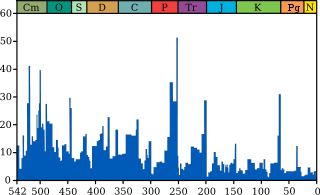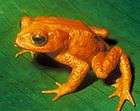Eocene–Oligocene extinction event
The Eocene–Oligocene extinction event, the transition between the end of the Eocene (33.9 Ma) and the beginning of the Oligocene, is marked by large-scale extinction and floral and faunal turnover (although minor in comparison to the largest mass extinctions).[1] Most of the affected organisms were marine or aquatic in nature. They included the last of the ancient cetaceans, the Archaeoceti.
This was a time of major climatic change, especially cooling, not clearly caused by any single major impact or volcanic event.[2] Extended volcanic activity is one possible cause. Another speculation points to several large meteorite impacts near this time, including those of the Chesapeake Bay crater 40 km (25 mi) and the Popigai crater 100 km (62 mi) of central Siberia, which scattered debris perhaps as far as Europe. New dating of the Popigai meteor strengthens its association with the extinction.[3]
A leading model of climate cooling at this time predicts a decrease in atmospheric carbon dioxide, which slowly declined in the mid to late Eocene and possibly reached some threshold approximately 34 million years ago. This boundary is closely linked with the Oligocene Oi-1 event, an oxygen isotope excursion that marks the beginning of ice sheet coverage on Antarctica.[4][5]
Grande Coupure
The Grande Coupure, or "great break" in continuity,[6] with a major European turnover in mammalian fauna about 33.5 Ma, marks the end of the last phase of Eocene assemblages, the Priabonian, and the arrival in Europe of Asian species. The Grande Coupure is characterized by widespread extinctions and allopatric speciation in small isolated relict populations.[7] It was given its name in 1910 by the Swiss palaeontologist Hans Georg Stehlin,[8] to characterise the dramatic turnover of European mammalian fauna, which he placed at the Eocene-Oligocene boundary. A comparable turnover in Asian fauna has since been called the "Mongolian Remodelling".
The Grande Coupure marks a break between endemic European faunas before the break and mixed faunas with a strong Asian component afterwards. J. J. Hooker and his team summarized the break:[9]
- "Pre-Grande Coupure faunas are dominated by the perissodact family Palaeotheriidae (distant horse relatives), six families of artiodactyls (cloven-hoofed mammals) (Anoplotheriidae, Xiphodontidae, Choeropotamidae, Cebochoeridae, Dichobunidae and Amphimerycidae), the rodent family Pseudosciuridae, the primate families Omomyidae and Adapidae, and the archontan family Nyctitheriidae.
- "Post-Grande Coupure faunas include the true rhinoceros (family Rhinocerotidae), three artiodactyl families (Entelodontidae, Anthracotheriidae and Gelocidae) related respectively to pigs, hippos and ruminants, the rodent families Eomyidae, Cricetidae (hamsters) and Castoridae (beavers), and the lipotyphlan family Erinaceidae (hedgehogs). The speciose genus Palaeotherium plus Anoplotherium and the families Xiphodontidae and Amphimerycidae were observed to disappear completely.
- "Only the marsupial family Herpetotheriidae, the artiodactyl family Cainotheriidae, and the rodent families Theridomyidae and Gliridae (dormice) crossed the faunal divide undiminished."
It has been suggested that this was caused by climate change associated with the earliest polar glaciations[10] and a major fall in sea levels, or by competition with taxa dispersing from Asia. However, few argue for an isolated single cause. Other possible causes are related to the impact of one or more large bolides in northern hemisphere at Popigai, Toms Canyon and Chesapeake Bay. Improved correlation of northwest European successions to global events[9] confirms the Grande Coupure as occurring in the earliest Oligocene, with a hiatus of about 350 millennia prior to the first record of post-Grande Coupure Asian immigrant taxa.
An element of the paradigm of the Grande Coupure was the apparent extinction of all European primates at the Coupure: the 1999 discovery[11] of a mouse-sized early Oligocene omomyid, reflecting the better survival chances of small mammals, further undercut the Grand Coupure paradigm.
Evidence in the world's ocean current system indicates an abrupt cooling from 34.1 to 33.6 Ma across the Eocene–Oligocene boundary at 33.9 Ma. The remarkable cooling period in the ocean is correlated with pronounced mammalian faunal replacement within continental Asia as well. The Asian biotic reorganization events are comparable to the Grande Coupure in Europe and the Mongolian Remodeling of mammalian communities.[12] The global cooling is also correlated with marked drying conditions in low-latitudes Asia.[13]
References
- Ivany, Linda C.; Patterson, William P.; Lohmann, Kyger C. (2000). "Cooler winters as a possible cause of mass extinctions at the Eocene/Oligocene boundary" (PDF). Nature. 407 (6806): 887–890. Bibcode:2000Natur.407..887I. doi:10.1038/35038044. hdl:2027.42/62707. PMID 11057663.
- Molina, Eustoquio; Gonzalvo, Concepción; Ortiz, Silvia; Cruz, Luis E. (2006-02-28). "Foraminiferal turnover across the Eocene–Oligocene transition at Fuente Caldera, southern Spain: No cause–effect relationship between meteorite impacts and extinctions". Marine Micropaleontology. 58 (4): 270–286. Bibcode:2006MarMP..58..270M. doi:10.1016/j.marmicro.2005.11.006.
- "Russia's Popigai Meteor Crash Linked to Mass Extinction". June 16, 2014.
- Zachos, James C.; Quinn, Terrence M.; Salamy, Karen A. (1996-06-01). "High-resolution (104 years) deep-sea foraminiferal stable isotope records of the Eocene-Oligocene climate transition". Paleoceanography. 11 (3): 251–266. Bibcode:1996PalOc..11..251Z. doi:10.1029/96PA00571. ISSN 1944-9186.
- Shackleton, N. J. (1986-10-01). "Boundaries and Events in the Paleogene Paleogene stable isotope events". Palaeogeography, Palaeoclimatology, Palaeoecology. 57 (1): 91–102. Bibcode:1986PPP....57...91S. doi:10.1016/0031-0182(86)90008-8.
- also termed the MP 21 event.
- Called "dispersal-generated origination" in Hooker et al. 2004
- Stehlen, H.G. (1910). "Remarques sur les faunules de Mammifères des couches eocenes et oligocenes du Bassin de Paris". Bulletin de la Société Géologique de France. 4 (9): 488–520.
- Hooker, J.J.; Collinson, M.E.; Sille, N.P. (2004). "Eocene-Oligocene mammalian faunal turnover in the Hampshire Basin, UK: calibration to the global time scale and the major cooling event". Journal of the Geological Society. 161 (2): 161–172. doi:10.1144/0016-764903-091.
- A major cooling event preceded the Grande Coupure, based on pollen studies in the Paris Basin conducted by Chateauneuf (J.J. Chateauneuf, 1980. "Palynostratigraphie et paleoclimatologie de l'Éocene superieur et de l'Oligocene du Bassin de Paris (France)" in Mémoires du Bureau de Recherches Géologiques et Minières, 116 1980).
- Köhler, M; Moyà-Solà, S (December 1999). "A finding of oligocene primates on the European continent". Proceedings of the National Academy of Sciences of the United States of America. 96 (25): 14664–7. Bibcode:1999PNAS...9614664K. doi:10.1073/pnas.96.25.14664. ISSN 0027-8424. PMC 24493. PMID 10588762.
- Zhang, R.; Kravchinsky, V.A.; Yue, L. (2012). "Link between Global Cooling and Mammalian Transformation across the Eocene-Oligocene Boundary in the Continental Interior of Asia]". International Journal of Earth Sciences. 101 (8): 2193–2200. Bibcode:2012IJEaS.101.2193Z. doi:10.1007/s00531-012-0776-1.
- Li, Y. X.; Jiao, W. J.; Liu, Z. H.; Jin, J. H.; Wang, D. H.; He, Y. X.; Quan, C. (2016-02-11). "Terrestrial responses of low-latitude Asia to the Eocene–Oligocene climate transition revealed by integrated chronostratigraphy". Clim. Past. 12 (2): 255–272. Bibcode:2016CliPa..12..255L. doi:10.5194/cp-12-255-2016. ISSN 1814-9332.

